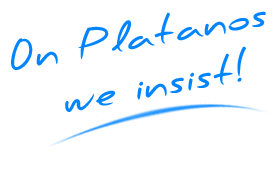THE FIRST INHABITANTS IN PLATANOS - HISTORICAL DATA
There are no historical data to prove clearly the timing and onset of colonization of Platanos. But it is certain that during the Ottoman and Venetian interim, the present geographic space wasn't unknown or uninhabited.
The presence of the Turkish officer (aka Ali - Agha - or Bei) in Kefalianika proves that there is a large village which ruled the area by gathering taxes, processing information and reporting to the overlying authority settled in Kalavryta. Therefore during the difficult years there is an administrative articulation according to the Ottoman law, either as an autonomous local authority, either as a wider administrative authority.
There are sources that indicate the existence of a council of elders in Zarouchla and Agia Varvara. More likely is the existence of up to two dignitaries of the province, aka "morogianides".
An important historical point is the census of GRIMANI in 1700 in the village. There were 15 families, 46 men and 35 women, totalling 81 people from one year up to sixty years of age.This proves that in the middle of the Turkish occupation, people stayed in the village either because they hardly accepted the local Turkish authority, or worked for the Venetian commanders. Probably what happened was the second one, because from 1685 until 1715 the occupation and prevalence of Venetian rule followed the Turkish occupation.
However, it is difficult to ascertain the exact time in which Platanos became a village with permanent inhabitants, before the liberation. Since 1826, some inhabitants of Ano Potamia moved to Platanos. This fact marks the beginning of colonization with permanence and social composition. In 1836 is reported the existence of the church of Saint Andrew.
THE PEOPLE OF ANO POTAMIA & THE NAME PLATANOS
People from various places, indigenous and foreign, farmers, sericulturists, builders, lumberjacks and craft workers living in Ano Potamia, (in the riverside area of Krathis river located in altitude of 1025m., at the slopes of Helmos mountain), were the new inhabitants of Platanos.
The people from Ano Potamia lived on farming, agriculture and sericulture. During the winter, life was difficult because of the snow that coveed everything for several months. So the first inhabitants with their families used to leave the village and go down to lower areas to spend the winter.
Starting together in November by helping each other and agree with those who were left behind that they will meet again in Platanos.
The journey with the slow pace of the animals, took an autumn day. In today's Platanos, in the region of Ano Vryses was (now is only a memory) a big old plane tree with hollow thick trunk which had large openings like caves where two people could sleep in. The animals rested beneath the bare branches, beside the rich bushy grass, drinking water from the springs. From this very tree that was the meeting point, Platanos village took its name.
The place is bare of trees. There are evergreen shrubs and grass. Residents share the area and remain there for five months. With the first signs of spring they are in a hurry to go back to their lodgings, always terrified of pirates who were ruling the seas and plundering the coastal region. Over the time, bandits and pirates disappeared. Slowly and reluctantly the residents of Ano Potamia became bold and came to Platanos. They were few in the beginning, but even more later, in the early years of the 19th century. They stayed in simple constructions imitating others who had built theirs by use of: large stones and mud, while keeping a small door. They now have a permanent residence, their hut (kalyvi).
From now on, every year, the meeting point will be kalyvia (huts) in Platanos. They could build better houses, but the Turk Ali was very strict and wouldn't allow room for luxurious living to foreign rayahs. He lived in a house, a little further from Platanos, in Kefalochori - today a.k.a the current settlement of Kefalianika - and only there it was permitted the building of houses with an elementary technique, with permanent roof and small windows.
The eastern inhabited part, where the houses of George Mamarelis, Christos Mandas, Kazanis etc. are located, was called Pera Kalyvia. The houses there had a very small window facing Kefalianika. The population growth is influenced by several primary or secondary factors such as national developments, economic and political reforms, agriculture, immigration and lifestyle. In the newly established village of Platanos, everything was dynamic and interdependent.
INFORMATION SOURCES:
The book of the teacher Sotirios G. Moutzourelis, "Platanos-Ano Potamia-Tsivlos, the Place and it’s People." (Publication is an offer from Alexiou Ch. Siaflas. Distributed free until exhaustion of copies, by the Board of the cultural association "Pegasus").

